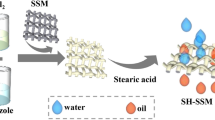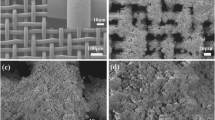Abstract
Oily water treatment has attracted the attention of many researchers. The development of effective and cheap oil/water separation materials is urgent for treating this problem. Herein, inspired by superhydrophobic typical plant leaves such as lotus, red rose and marigold, superhydrophobic and superoleophilic copper mesh was fabricated by etching and then surface modification with 1-dodecanethiol (HS(CH2)11CH3). A rough silver layer is formed on the mesh surface after immersion. The obtained mesh surface exhibits superhydrophobicity and superoleophilicity and the static water contact angle was 153° ± 3°. In addition, the as-prepared copper mesh shows self-cleaning character with water and chemical stability. The as-prepared copper foam can easily remove the organic solvents either on water or underwater. We demonstrate that by using the as-prepared mesh, oils can be absorbed and separated, and that high separation efficiencies of larger than 92% are retained for various oils. Thus, such superhydrophobic and superoleophilic copper mesh is a very promising material for the application of oil spill cleanup and industrial oily wastewater treatment.
Similar content being viewed by others
References
Peng H L, Wang H, Wu J N, Meng G H, Wang Y X, Shi Y L, Liu Z Y, Guo X H. Preparation of superhydrophobic magnetic cellulose sponge for removing oil from water. Industrial & Engineering Chemistry Research, 2016, 55, 832–838.
Li S Q, Li N X, Yang S B, Liu F Y, Zhou J C. The synthesis of a novel magnetic demulsifier and its application for the demulsification of oil-charged industrial wastewaters. Journal of Materials Chemistry A, 2014, 2, 94–99.
Chen M D, Jiang W, Wang F H, Shen P, Ma P C, Gu J J, Mao J Y, Li F S. Synthesis of highly hydrophobic floating magnetic polymer nanocomposites for the removal of oils from water surface. Applied Surface Science, 2013, 286, 249–256.
Zhang L, Li L L, Dang Z M. Bio-inspired durable, superhydrophobic magneticparticles for oil/water separation. Journal of Colloid and Interface Science, 2016, 463, 266–271.
Hilal N, Busca G, Hankins N, Mohammad A W. The use of ultrafiltration and nanofiltration membranes in the treatment of metal-working fluids. Desalination, 2004, 167, 227–238.
Hu B, Scott K. Influence of membrane material and corrugation and process conditions on emulsion microfiltration. Journal of Membrane Science, 2007, 294, 30–39.
Elias E, Costa R, Marques F, Oliveira G, Guo Q, Thomas S, Ferenando Jr G S. Oil-spill cleanup: The influence of acetylated curaua fibers on the oil-removal capability of magnetic composites. Journal of Applied Polymer Science, 2015, 132, 41732–41739.
Zouboulis A I, Avranas A. Treatment of oil-in-water emulsions by coagulation and dissolved-air flotation. Colloids and Surfaces A: Physicochemical and Engineering Aspects, 2000, 172, 153–161.
Al-Shamrani A A, James A, Xiao H. Separation of oil from water by dissolved air flotation. Colloids and Surfaces A: Physicochemical and Engineering Aspects, 2002, 209, 15–26.
Al-Shamrani A A, James A, Xiao H. Destabilisation of oil-water emulsions and separation by dissolved air flotation. Water Research, 2002, 36, 1503–1512.
Liu C, Yang J, Tang Y C, Yin L T, Tang H, Li C S. Versatile fabrication of the magnetic polymer-based graphene foam and applications for oil-water separation. Colloids and Surfaces A: Physicochemical and Engineering Aspects, 2015, 468, 10–16.
Zhou M, Li J, Wu C X, Zhou X K, Cai L. Fluid drag reduction on superhydrophobic surfaces coated with carbon nanotube forests (CNTs). Soft Matter, 2011, 7, 4391–4396.
Su B, Li M, Lu Q. Toward understanding whether superhydrophobic surfaces can really decrease fluidic friction drag. Langmuir, 2010, 26, 6048–6052.
Bixler G D, Bhushan B. Fluid drag reduction and efficient self-cleaning with rice leaf and butterfly wing bioinspired surfaces. Nanoscale, 2013, 5, 7685–7710.
Xu Q F, Liu Y, Lin F, Mondal B, Lyons A M. A superhydrophobic TiO2-polymer nanocomposite surface with UV-induced reversible wettability and self-cleaning properties. ACS Applied Materials & Interfaces, 2013, 5, 8915–8924.
Bixler G D, Bhushan B. Rice-and butterfly-wing effect inspired self-cleaning and low drag micro/nanopatterned surfaces in water, oil, and air flow. Nanoscale, 2014, 6, 76–96.
Yu S, Wang X, Wang W, Yao Q, Xu J, Xiong W. A new method for preparing bionic multi scale superhydrophobic functional surface on X7pipeline steel. Applied Surface Science, 2013, 271, 149–155.
Xu W J, Song J L, Sun J, Lu Y, Yu Z Y. Rapid fabrication of large-area, corrosion-resistant superhydrophobic Mg alloy surfaces. ACS Applied Materials & Interfaces, 2011, 3, 4404–4414.
Peng C W, Chang K C, Weng C J, Lai M C, Hsu C H, Hsu S C, Hsu Y Y, Hung W I, Wei Y, Yeh J M. Nano-casting technique to prepare polyaniline surface with biomimetic superhydrophobic structures for anticorrosion application. Electrochimica Acta, 2013, 95, 192–199.
Gao X F, Yan X, Yao X, Xu L, Zhang K, Zhang J, Yang B, Jiang L. The dry-style antifogging properties of mosquito compound eyes and artificial analogues prepared by soft lithography. Advanced Materials, 2007, 19, 2213–2217.
Sun Z, Liao T, Liu K, Jiang L, Kim J H, Dou S X. Fly-eye inspired superhydrophobic anti-fogging inorganic nanostructures. Small, 2014, 10, 3001–3006.
Zhang X, Shi F, Niu J, Jiang Y G, Wang Z Q. Superhydrophobic surfaces: From structural control to functional application. Journal of Materials Chemistry A, 2008, 18, 621–633.
Darmanina T, Guittard F. Recent advances in the potential applications of bioinspired superhydrophobic materials. Journal of Materials Chemistry A, 2014, 2, 16319–16359.
Shawat E, Perelshtein I, Westover A, Pintb C L, Nessim G D. Ultra high-yield one-step synthesis of conductive and superhydrophobic three-dimensional mats of carbon nanofibers via full catalysis of unconstrained thin films. Journal of Materials Chemistry A, 2014, 2, 15118–15123.
Zhao L, Liu W L, Zhang L D, Yao J S, W H Xu, X Q Wang, Y Z Wu. Fabrication of superhydrophobic and conductive surface based on carbon nanotubes. Colloids and Surfaces A: Physicochemical and Engineering Aspects, 2013, 423, 69–76.
Feng L, Zhang Z, Mai Z, Ma Y, Liu B, Jiang L, Zhu D. A super-hydrophobic and super-oleophilic coating mesh film for the separation of oil and water. Angewandte Chemie International Edition, 2004, 43, 2012–2014.
Feng J, Jiang L. Design and creation of superwetting/ antiwetting surfaces. Advanced Materials, 2006, 18, 3063–3078.
Yang H, Pi P H, Cai Z Q, Wen X F, Wang X B, Cheng J, Yang Z R. Facile preparation of super-hydrophobic and super- oleophilic silica film on stainless steel mesh via sol-gel process. Applied Surface Science, 2010, 256, 4095–4102.
Guo, W, Zhang, Q, Xiao H, Xu J, Li Q, Pan X, Huang Z. Cu mesh’s super-hydrophobic and oleophobic properties with variations in gravitational pressure and surface components for oil/water separation applications. Applied Surface Science, 2014, 314, 408–414.
Li J J, Zhou Y N, Jiang Z D, Luo Z H. Electrospun fibrous mat with pH-switchable superwettability that can separate layered oil/water mixtures. Langmuir, 2016, 32, 13358–13366.
Ge J L, Zhang J C, Wang F, Li Z L, Yu J Y, Ding B. Superhydrophilic and underwater superoleophobic nanofibrous membrane with hierarchical structured skin for effective oil-in-water emulsion separation. Journal of Materials Chemistry A, 2017, 5, 497–502.
Crick C R, Gibbins J A, Parkin I P. Superhydrophobic polymer-coated copper-mesh; membranes for highly efficient oil-water separation. Journal of Materials Chemistry A, 2013, 1, 5943–5948.
Zhang J, Seeger S. Polyester materials with superwetting silicone nanofi laments for oil/water separation and selective oil absorption. Advanced Functional Materials, 2011, 21, 4699–4704.
Pan Q M, Wang M, Chen W T. Hydrophobization of metal surfaces by covalent grafting of aromatic layer via aryldiazonium chemistry and their application in the fabrication of superhydrophobic surfaces. Chemistry Letters, 2007, 36, 1312–1313.
Larmour A, Bell S E J, Saunders G C. Remarkably simple fabrication of superhydrophobic surfaces using electroless galvanic deposition. Angewandte Chemie International Edition, 2007, 46, 1710–1712.
Zhu H, Guo Z G. Understanding the separations of oil/water mixtures from immiscible to emulsions on super-wettable surfaces. Journal of Bionic Engineering, 2016, 13, 1–29.
Author information
Authors and Affiliations
Corresponding author
Rights and permissions
About this article
Cite this article
Song, Y., Liu, Y., Zhan, B. et al. Fabrication of bioinspired structured superhydrophobic and superoleophilic copper mesh for efficient oil-water separation. J Bionic Eng 14, 497–505 (2017). https://doi.org/10.1016/S1672-6529(16)60416-X
Published:
Issue Date:
DOI: https://doi.org/10.1016/S1672-6529(16)60416-X




